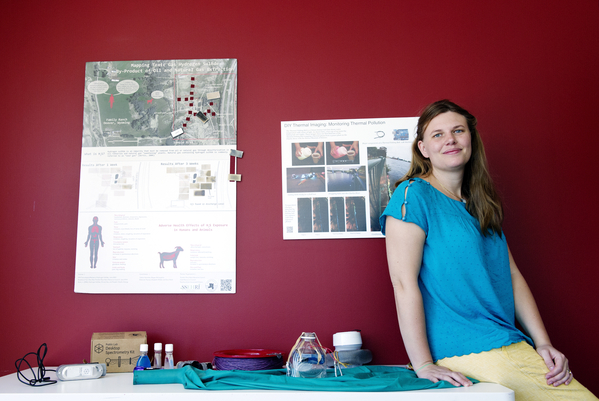Re-making science

In its earliest days, the process of science was validated by a group of regular people bearing witness to a peer’s experiment or observation. So-called “gentleman scientists” would gather around something like Robert Boyle’s air pump experiment to verify the designer’s conclusions. “This is how the Royal Societies started,” explained Sara Wylie, an assistant professor in Northeastern University’s Social Science and Environmental Health Research Institute.
Today, science is a job not for the masses but for a select group of people with years of academic training and expertise in the lab. But on Wednesday at the first-ever White House Maker Faire, President Barack Obama told attendees—including Wylie—that the spirit of doing is still quite alive in each of us. “[The United States] is a place where we know how to invent and we know how to dream and we know how to take risks.” He added, “This is a place where people who work hard have always been able to make it.”
But on this day, the words “make it” referred to more than career success and financial stability. They also spoke to the literal idea of making, as the nation turned its sights to the growing Maker Movement—a tech-based version of the do-it-yourself approach when people are equipped with the resources and motivation to create something to improve our communities and our world.
Wylie, who holds joint appointments in the College of Social Sciences and Humanities and the Bouvé College of Health Sciences at Northeastern, was among more than 100 presenters at the Maker Faire. At the event, President Obama, the first lady, and representatives from 11 different government agencies met with students, entrepreneurs, and everyday citizens to learn about the innovative ways they are “inventing the future” by using new tools and techniques to launch businesses and learn skills in the STEM fields—science, technology, engineering, and math. Obama declared the day the first ever National Day of Making.
Wylie argues that when it comes to civic science, people have the motivation but lack the resources to answer their scientific questions. That’s why in 2010, Wylie and her colleagues founded Public Lab to provide these resources. Public Lab is an online, do-it-yourself environmental science community that provides low-cost tools for regular people to do high-quality, reproducible science.

Wylie and her Public Lab colleague Eymund Diegel had the opportunity to speak with President Obama directly about their work. Photo courtesy of Wall Street Journal / Associated Press.
At the Makers Faire, she presented her work at Public Lab to make this do-it-yourself science possible for helping people to solve problems in their communities. These include landowners in Deaver, Wyoming, who are developing the symptoms of hydrogen sulfide exposure as oil and gas extraction companies encroach on their properties. It’s residents of Chicago’s South Side who live next to toxic waste piles and it’s students who want to improve the water quality of their rivers and streams.
Wylie hasn’t always thought of herself as part of the Maker Movement. “The questions that motivate me are actually theoretical and cultural: how and why have the sciences developed historically? What are the blind spots and assumptions built into our present modes of science and research tools? And how can we redevelop both the structure of scientific communities and our research tools to better study pressing environmental health questions?” she said. It was those questions that lead her to the Maker Movement.
But that journey has turned her into a maker. She’s had to learn electronics and environmental sensing methods, she’s had to teach herself how to fly digital cameras from weather balloons and how to make spectrometers from broken CDs and webcams—to name a few.
These skills—along with the tools she’s creating with them and the new approach to science they are enabling—have placed her squarely in the middle the Maker Movement. A global community of people is using easy-to-access but state-of-the-art technologies such as 3-D printers and over-the-counter microcontrollers to imagine and build new devices, beautiful artwork, and everything in between.
She also integrates this interdisciplinary work into the classroom in courses such as Environment, Technology and Society and Community-Based Participatory Research.
Through her work, Wylie hopes to support people who are bearing witness to their environments and creating usable data from their experiences. She said that when citizens have the ability to use low-cost tools to monitor hazardous industries or confirm the validity of marketing claims that a particular detergent is environmentally safe, this work supports the efforts of federal agencies like the Environmental Protection Agency and the Food and Drug Administration.
“The message I wanted to get across to the White House is the idea that citizen science can support our federal government in many new ways,” she said.





